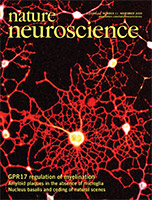Dr. Jianrong Li made the cover of this month’s issue of the prestigious scientific journal Nature Neuroscience
COLLEGE STATION, TX – A collaborative study in which Dr. Jianrong Li of the Texas A&M University College of Veterinary Medicine & Biomedical Sciences (CVM) was one of the contributing authors has made the cover of this month’s issue of the prestigious scientific journal Nature Neuroscience.

The study’s main finding is the identification of a protein called GPR17 and its potential to serve as a therapeutic target for the treatment of demyelinating diseases such as multiple sclerosis (MS), which affects 2 million people worldwide and is characterized by damage to myelin, the insulating layer of axons (long, slender projections of nerve cells that transmit nerve impulses).
The study explains how GPR17 is involved in controlling the maturation of myelin-forming cells, oligodendrocytes, in the central nervous system (CNS), a process that is poorly understood. The main function of these cells is to produce a myelin sheath around axons. Myelin production or myelination is crucial for the normal functioning of the central nervous system.
“Myelin not only speeds up the conduction of nerve impulses along axons but also keeps axons healthy. Without myelin, axons will eventually degenerate,” Li explained.
The study shows that GPR17 negatively regulates myelin development-that is, its overexpression inhibits myelination while its absence results in the early onset of myelination during CNS development.
Specifically, Li’s group showed that the overexpression of this protein in a culture of oligodendrocyte precursor cells arrests oligodendrocyte differentiation.
“GPR17 is upregulated in human MS plaques and in animal models of MS,” said Li. “In many MS cases, there are oligodendrocyte precursor cells in plaques, yet these cells fail to mature and myelinate axons. Therefore, it is of great interest to test whether blocking this receptor promotes myelin repair and functional recovery.”
The study was funded by grants from the National Institutes of Health (NIH) and the National Multiple Sclerosis Society.


